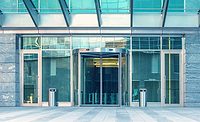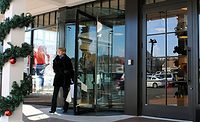How to Formulate a Holistic Approach for Effective Entrance Planning

Traditionally, security personnel begin with their building’s main entrances when planning to secure their facility. While that is an effective start, it is important to consider the entire facility or campus to ensure that all areas are protected.
Sectors that are already embracing this trend include corporate campuses, higher education, critical infrastructure, multi-tenant buildings, data centers and distribution centers – and it’s spreading to all industries and organizations. In this article, we’ll share how security entrances are deployed in layers across large properties to mitigate the risk of infiltration according to their capabilities.
The Three Legs of the Holistic Approach
As a quick reminder, security entrances are intended to fit into physical security planning that addresses People, Process and Technology. The People aspect involves curating a highly experienced and capable security team; Process is about creating well-defined, robust, flexible and adaptive processes and procedures; and Technology (which includes security entrances, access control systems, cameras, biometrics, etc.) encompasses an advanced, innovative and highly secure tool set. These three elements work together to formulate a holistic physical security plan that is used by the sectors in this article.
Now, here’s how these sectors are addressing the risk of infiltration by deploying security entrances in layers.
Corporate Campuses
Corporate headquarters require a range of differing solutions at entrances and exits to ensure that only authorized people are able to enter each section of the campus. These organizations can create multiple layers of access authority, for example, by using optical turnstiles with waist-high glass barriers to detect tailgating at the main building entrance and full-height security revolving doors or mantrap portals at the entrances to more restricted areas. This creates an open and more inviting impression for the main lobby area while maintaining higher security where it is necessary to secure sensitive information housed on certain floors, protect employees, or provide employee-only access to certain floors.
Higher Education
College and university campuses are difficult to secure because they are open to the public and often distributed across large tracts of land or blocks in urban locations. Campus security is responsible for the safety of staff, students and visitors. You can find optical turnstiles at the supervised entrances of libraries, residence halls, recreational facilities, dining halls and classroom buildings to deter and detect tailgating and facilitate visitors/guests. Parking areas, sports stadiums and other outdoor facilities deploy full-height and waist-high turnstiles to control the flow of traffic through entrances and exits, and can supervise them on an “as needed” basis.
Critical Infrastructure
With risks to critical infrastructure including terrorism and cyber breaches, these are some of our must vulnerable facilities. Dams, ports, railways, power plants and oil/gas facilities must comply with federal or state regulations or pay hefty fines for infractions. Full-height turnstiles on the fence line deter public access into dangerous, outdoor areas. Then the entrances to buildings and areas that are more sensitive rely on either supervised turnstiles or security mantrap portals to prevent unauthorized entry. Often biometric technology, such as iris or facial recognition, confirms the identity of employees entering sensitive areas and the access control system records the entry.
Multi-Tenant Commercial Buildings
Security challenges in a multi-tenant space are diverse, as each tenant provides different services with individualized needs. With the wide range of security entrances available, each tenant can tailor the level of security (do they want to deter, detect or prevent infiltration?) to match their requirements.
Data Centers
It is vitally important to protect data centers from physical breaches, as they enable hackers to easily access networks to steal, corrupt or ransom intellectual property, personal data and other information. At the fence line, you’ll find full-height turnstiles with security cameras to deter casual pedestrian intrusion. At the main entry into the facility supervised optical turnstiles facilitate the entry of employees and escorted guests. The final “nucleus” layer includes the servers in the cold room; to enter, you’ll encounter mantrap security portals that prevent piggybacking attempts and are ideal for two-factor authentication protocol. If a user satisfies both factors (credential and identity) and most importantly, they are alone, they can enter.
Distribution Centers and Manufacturing Facilities
Distribution centers and manufacturing facilities don’t generally admit the public, but security is required to protect employees, physical assets and also prevent theft. This sector relies on lower cost, robust entrance solutions. Economical full-height turnstiles perform double duty both inside and outside: at the perimeter fence line and again inside where workers enter the floor or warehouse (often in conjunction with metal detectors to ensure no weapons are brought in). Then, full-height turnstiles are used again as a one-way exit solution. As a theft deterrent, we’ve also seen tripod turnstiles used to process employees for random pat-downs before they leave for the day.
The layered approach is one driver behind the growing security entrance market. No matter what industry you are in, you have an opportunity to use security entrances to harden your facility areas beyond the front door.
Looking for a reprint of this article?
From high-res PDFs to custom plaques, order your copy today!






